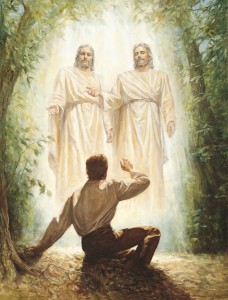 My seven year old nephew recently announced to his mother that there are more boys than girls on the earth. My sister asked,”Why do you think that?” He explained,
My seven year old nephew recently announced to his mother that there are more boys than girls on the earth. My sister asked,”Why do you think that?” He explained,
“Because Heavenly Father and Jesus are boys, there must be more boys on the earth.”
My sister said she wasn’t sure if there were more boys than girls, that the numbers were probably near equal. She also reminded him that we have a Mother in Heaven and she is part of our Heavenly Family. My nephew said,
“Yeah, but Heavenly Father and Jesus have powers and stuff.”
Not yet defeated, my sister explained that Heavenly Mother is powerful too, and we probably have sisters up there in heaven that we just don’t know about. Then my nephew wanted to know if he could pray to Heavenly Mother. My sister said, “Well, we’ve been asked not too, but you can think about her and remember her always.”
At the age of seven my nephew understands in the simplest terms that male is more. My sister is a powerful woman. She leads in gospel instruction in the home. Each night at bedtime she reads scriptures and The Friend magazine with my nephew (carefully editing the stories in The Friend Magazine when they diverge from a path of equality and empowerment). She tells him stories of strong women and has certainly never intentionally taught that male is more. How did her son become convinced that there are more boys in the world than girls? He is quite comfortable with a perception that the world in unequal and that he is part of the more privileged group.
I have thought about this conversation often as I prepare lessons for my primary class of three and four year old children. As a former elementary school teacher I have experienced the powerful instructional impact of images on young children. Watching the documentary Miss Representation on the impact of media on gender inequality I was struck by the quote, “You can’t be what you can’t see.”
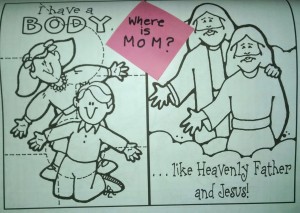 What does this mean at church? In LDS theology boys grow up to be like Heavenly Father and Jesus Christ and LDS girls grow up to be like…? The images say we grow up to be like Heavenly Father and Jesus Christ. But that is not true. Most females won’t become males as they grow up. In sidebar conversations we explain that LDS girls will one day be exalted like our Heavenly Mother. LDS girls are instructed to grow to be like someone they never see.
What does this mean at church? In LDS theology boys grow up to be like Heavenly Father and Jesus Christ and LDS girls grow up to be like…? The images say we grow up to be like Heavenly Father and Jesus Christ. But that is not true. Most females won’t become males as they grow up. In sidebar conversations we explain that LDS girls will one day be exalted like our Heavenly Mother. LDS girls are instructed to grow to be like someone they never see.
I make an effort to include many images with each lesson, including stories from Girls Who Choose God, illustrated scripture stories, and activities from Sunday Savers (not endorsed by the Church for use in Primary, but sold at Deseret Book). I try to use a balanced number of male and female images represented by a variety of races. But when it comes to teaching children about how they have a body in the image of God, I am stuck.
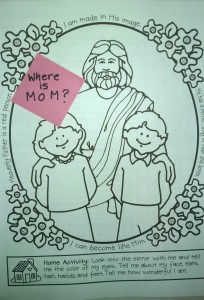 My Sunday Savers are filled with images of boys and girls who will grow up to be like Heavenly Father. Heavenly Mother is absent. Young children are all about the concrete. They know what they see, touch, taste, smell, and hear. They color an adult male and a child male and a child female. What does it do to a generation of women if as girls the only perfect heavenly bodies they see are male?
My Sunday Savers are filled with images of boys and girls who will grow up to be like Heavenly Father. Heavenly Mother is absent. Young children are all about the concrete. They know what they see, touch, taste, smell, and hear. They color an adult male and a child male and a child female. What does it do to a generation of women if as girls the only perfect heavenly bodies they see are male?
In the second week of Sunbeams a picture of Joseph Smith’s First Vision experience introduces the children to the concept that Heavenly Father has a body. We know the Father and Son have bodies of flesh and blood by an eyewitness account. Joseph Smith kneeling at their feet is a human male in the image of perfected males.
Although I tell the boys and girls that we have bodies like our Heavenly Parents and specify that boys can grow to be like Father in Heaven and girls can be like Mother in Heaven, the pictures recommended for this lesson only show male bodies. They shout a story far louder than my narrative of Heavenly Parents. Heavenly Mother is missing. The divine potential of a little girl is invisible. An empty space where mother should be.
What if I sent home this coloring picture of Heavenly Mother with a caption added, “I am made in Her image?”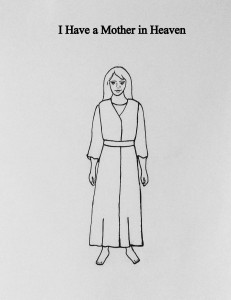
Are we comfortable with boys imagining themselves in a female body? Do we expect them to mentally edit their anatomy to match the picture as girls are obliged to do?
Instead, the most readily available images say nothing of our missing Mother in Heaven as they proclaim that our Heavenly Father has a partner in the male bodied Jesus Christ. 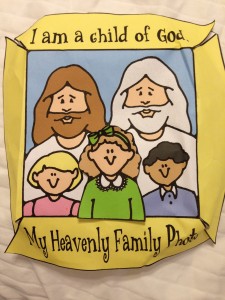 The “Heavenly Family Photo” looks a lot like my favorite California gay hipster couple with their beautiful adopted children. In a Church intensely focused on families led by heterosexual partners, the female body is strangely absent. There are no heavenly representations of Heavenly Mother in the Gospel Art Picture kit. No luminous art with an image of a wise loving Goddess. What would it be like if artistic depictions of our Heavenly Parents graced the walls of our Church buildings and provided illustrations for our lessons and magazines? Is it dangerous to imagine a perfected female body that is glorious and divine?
The “Heavenly Family Photo” looks a lot like my favorite California gay hipster couple with their beautiful adopted children. In a Church intensely focused on families led by heterosexual partners, the female body is strangely absent. There are no heavenly representations of Heavenly Mother in the Gospel Art Picture kit. No luminous art with an image of a wise loving Goddess. What would it be like if artistic depictions of our Heavenly Parents graced the walls of our Church buildings and provided illustrations for our lessons and magazines? Is it dangerous to imagine a perfected female body that is glorious and divine?
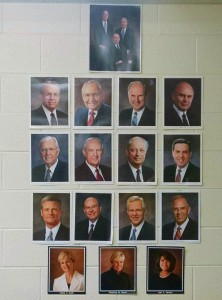 My class sits in the front row of the primary room facing a wall hung with the pictures of the First Presidency and the Quorum of the Twelve Apostles. Underneath the pictures of the Quorum of the Twelve are pictures of the General Primary Presidency printed from the Church media site (please e-mail the distribution site and request that they make them available for purchase). My class asks about “the lady apostles.” I explain that they are not apostles, but that they are the women in charge of Primary for all of the children in the world.
My class sits in the front row of the primary room facing a wall hung with the pictures of the First Presidency and the Quorum of the Twelve Apostles. Underneath the pictures of the Quorum of the Twelve are pictures of the General Primary Presidency printed from the Church media site (please e-mail the distribution site and request that they make them available for purchase). My class asks about “the lady apostles.” I explain that they are not apostles, but that they are the women in charge of Primary for all of the children in the world.
I hope that images of women who are good and lead may provide some hint to little girls of what they can be. I worry that the absent and silent Heavenly Mother represented in our lessons and images sends a message to girls that one day when they are exalted they too can be invisible. It tells my nephew that there are more boys in the world than girls. It tells him that men are more.
How do you teach children to be like a Heavenly Mother we can’t see in images or pray to directly? How do you help girls to see what they can be?


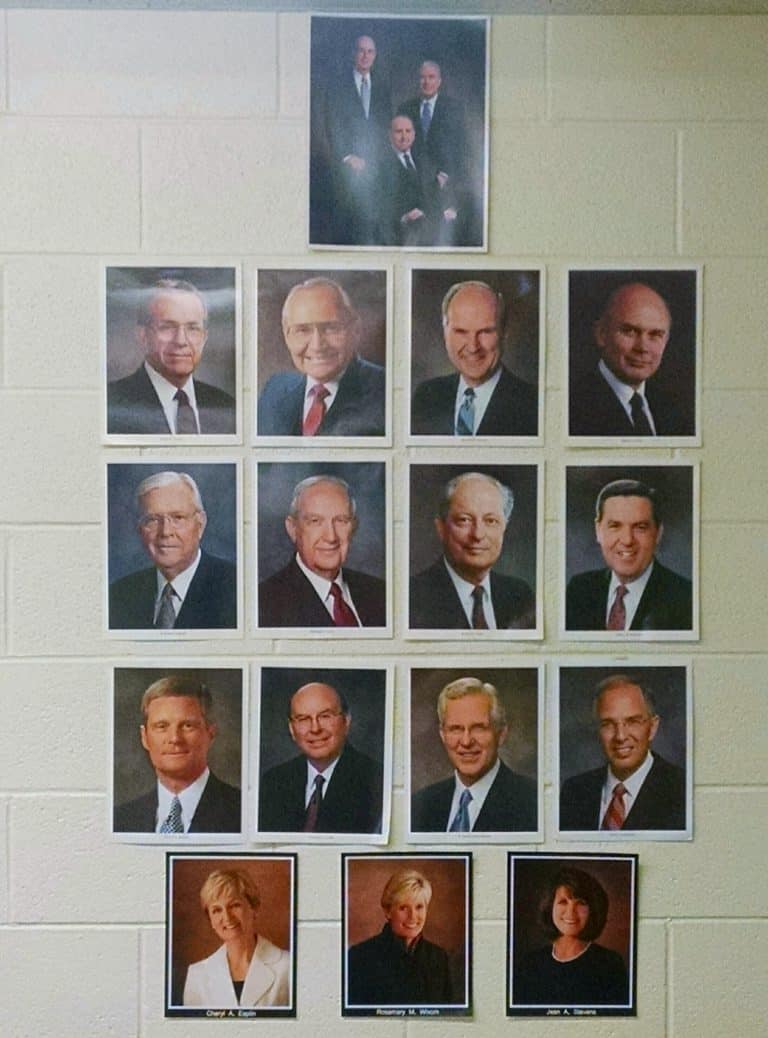



49 Responses
When I taught nursery, I made a nursery page to match the one in the nursery manual about having a body like Heavenly Father. Here’s mine.
Top Hat I love your nursery picture! I’m going to use it with my class.
Love it!
This is so, so perfectly explained, Cruelest Month, and so, so sad. Kids can see the inequality, and they internalize it. It’s disappointing that so many adults will go through all kinds of mental gymnastics to pretend it’s not there.
Also, the lack of images of exalted women or women in authority is exacerbated by the Church’s teachings on gender roles. Every time we hear again about the bright line between men’s roles and women’s roles, it makes the absence of women in our idea of the afterlife all the more glaring. It really communicates the message that women are to be eternally subservient, silent, out of the picture.
Thanks again for bringing this up; it’s so disturbing.
Truly. I remember a talk by Gordon B Hinckley where he addressed the question of an adolescent girl of whether or not she could get into heaven – because it was not at the time explicitly stated. So much of what we ‘understand’ about exalted female roles is not actually taught, it is just assumed to be understood. For instance, on earth we are taught that one of women’s roles is creation in bringing children to this earth. But when we talk about the creation of the earth or Adam and Eve’s physical bodies, there is no mention of Heavenly Mother. Is creation one of Her roles? If so why are we not taught about Her part in the creation of earth or Adam and Eve’s earthly bodies?
Personally I think it is unlikely we are going to get any more light on this subject until the church fundamentally changes. In part I think we are denied this light because, as a church, we are not quite on the right path. But in part I think it is also because there are not enough women in a position of authority to petition God, and so add to our doctrine and understanding (from the top down, rather than the bottom up). Of course, we also have to stop being afraid to be different from other religions (we are so too Christian!) and fully embrace this most beautiful truth of a Heavenly Mother.
Rachel, I remember that talk well and have written about it multiple times over the years.
The thing that stuck out at me was that President Hinckley seemed sincerely surprised that the girl did not understand. What surprised me was that he was surprised! How could the basic scriptural gender problem not be obvious?
Sometimes man means “mankind.” Sometimes (apparently) is just means males. Where is the gender parsing outlined for us???
Cruelest Month, thank you for the well thought out post.
This is one of my biggest frustrations. First, we generally tell everyone (male and female alike) that they are “trying to be like Jesus” while at the same time we loudly and clearly tell women they cannot become like Jesus. Then, parenthetically, we tell women they can be like Heavenly Mother, which means nothing because she’s absent.
A couple of years ago I wrote about a particular instance of the missing Heavenly Mother where our leaders seem unaware of the missing element.
It’s like the missing elephant in the room, isn’t it? 🙁
Loved your post Alison thanks for sharing. As part of an eating disorder recovery program I participated in we spent a lot of time on the concept that lack of a divine feminine role model underlies eating disorders. It made me so mad to see the potential in LDS theology to help inoculate and heal women from eating disorders with our knowledge of Heavenly Mother. Sad to see that potential unrealized as the Church promotes divine potential for father’s, while women’s potential is strictly defined in biological/earthly potential.
Had not thought of that aspect at all.
I can see Naismith’s point that this provides a sense of freedom, but I don’t see Heavenly Father’s presentation as compelling any man into a particular mold, unless it’s a mold of goodness. (Which is…good.)
Yes, it is like the missing elephant in the room! So how do LDS come to find this missing piece of the Gospel? The same way Joseph found his missing portion. In order to know Heavenly Mother, you need a….First Vision.
UGH. Yes. It’s so true. The absence is glaring and painful. If we really believe that we are made in the image of God, then why isn’t God alternately portrayed as male and female? Why is that so subversive?
I love TopHat’s matching coloring page linked above, and the picture of Heavenly Mother you posted, Cruelest Month. I also loved the artwork of Heavenly Mother from a contest last year (which I can’t seem to find on the internet… does anybody know where that all is?!) because it made her seem real. Concrete. Visible. Possible.
Try amotherhere.com
Thank you Anarene and Liz. Gorgeous and powerful images at amotherhere.com Where were they in my Google image search? shakes fist at Google
I’m impressed that your Primary has photos of the Primary leaders. That’s more than most wards do.
Some renegade put those up. With three wards in the building everyone blamed the other ward and the pictures stayed. Try it in your ward too!
I had this same problem with my Sunbeam class this month. I’m not much for drawing, so attempted to find a picture or clip art, anything with Heavenly Father and Heavenly Mother together, and came up empty. Every “couple” picture I could find was of Heavenly Father and Jesus, and as you showed, they looked like a gay couple co-parenting, not father and son pictures. (Top Hat, I’m going to save the coloring page you made for future use!!) In the end, I settled for talking about how we have a Heavenly Father and a Heavenly Mother and how we look like Them, and we had fun pointing to our noses and eyes and feet that look just like Theirs.
I don’t want to make the same mistake I used to make: One of my daughters, when she was around 8 or 9, came home from Primary one day and was angry. I asked what was wrong, and she demanded, “Why didn’t you TELL me there was a Heavenly Mother?” Her Primary teacher had talked about Heavenly Mother, and my daughter was hurt that I had known about Her and hadn’t said anything. Every night when I put that child to bed, I had told her, “Mommy and Daddy love you, and Heavenly Father and Jesus love you.” But I never even mentioned that she had a Heavenly Mother too. I just unthinkingly passed on the feminine emptiness that had been passed on to me.
The least I can do now that I know better is to actually say the words “Heavenly Mother” to my Sunbeams.
I confess I used a black and white coloring page picture of Abraham and Sarah while I talked about our Heavenly Parents. Your daughter’s accusation, “Why didn’t you tell me?” is devastating.
“One of my daughters, when she was around 8 or 9, came home from Primary one day…”
Yeah, Valiant manuals. All of them use explicit “heavenly parents” terminology when teaching about the pre-mortal life. I had one kid freaked about that. His mom was shocked at his reaction and thought that he’d been taught about HM before.
Since that is the only class I have taught, I didn’t realize that it wasn’t consistent across all grades.
I understand that the lack of concrete details about Heavenly Mother is a challenge for some women, and I do bring it up whenever it arises, so that everyone in the audience knows it is an issue.
But I don’t automatically jump to the conclusion that if someone is not as visible, their role is “less.” During my years in the military, I gained a keen appreciation for parachute packers. Doing that job right makes all the difference in the world to the person relying on it. Whatever happened to all that stuff in the Bible about first being last, etc.?
I think that one advantage of having the concept of Heavenly Mother somewhat vague is that we do not feel compelled to fit into a particular mold. We can each find our own unique way to magnify our unique gifts and fulfill our own potential.
Naismith, I agree that adults are capable of complex thoughts where the last shall be first and the first shall be last. Try using those lines on a three year old when you’re handing out fruit snacks. Developmentally the abstract and delay of gratification are far beyond the mastery of a young child. Three and four year olds are busy sorting and categorizing their world using concrete information, especially the visual and tactile. Imagining Heavenly Father and Jesus with artwork to support that imagining makes an abstract task possible for a young child. The lack of images for Heavenly Mother means no real knowledge or understanding until a child is old enough to read and understand at a primarily symbolic level. In the meantime children absorb and record many images of women as objects while waiting in a grocery checkout line or on TV.
Is it dangerous to imagine a perfected female body that is glorious and divine?
Is God portrayed as male and female subversive?
You bet it is. It’s subversive and dangerous to the idea that priesthood power on earth should be solely male. It’s subversive to patriarchy.
Next FHE at my house we’re doing TopHat’s coloring page.
I think this conversation about divine nature is one of the most important doctrinal conversations we can have. If gender is essential and eternal, where are the resurrected, glorified, exalted women?
I love your phrasing. One of the Young Women values is “Divine Nature.” If you actually stop and think about what that means, clearly we should be discussing Heavenly Mother and our potential to become like her. We have a divine nature because of her. But instead it is a sort of vague catch-all for having talents, or following commandments or….something. If acknowledging and learning about our divine nature is a core value, worth repeating every week and studying and practicing maybe we should actually center our faith more on the divine nature of women.
This is, for me, one of the most important (and yet most-glossed-over by LDS leaders) doctrines of the gospel. There is so much in our teachings about eternal families–and yet almost no public discussion of what an eternal, exalted family looks like.
“What does this mean at church? In LDS theology boys grow up to be like Heavenly Father and Jesus Christ and LDS girls grow up to be like…?”
This just hit me right in the gut. What an important point. I do have one glimmer of hope, though: During my freshman year at BYU, the Stake RS President gave a talk about Heavenly Mother during our ward’s RS hour. She said something to the effect of, “When we die, will we look like Heavenly Father? No! Man was created in God’s image. I have a female body! We will all be heavenly mothers and be like her.”
It was four years ago, but that lesson has still stuck with me. I wish more lessons were given like that and that women were reminded we do have a divine image that is separate from men.
East River Lady, I wish we could all have a dynamo Stake RS President preaching the truth of our Heavenly Mother! It is such a powerful concept. Put some solid revelation on Heavenly Mother in the Preach My Gospel manual and I’d bet we would see an impressive “hastening of the work.”
Love this post, Cruelest Month. I was just inspired by the idea that I need to do a scouting mission and see what kinds of images of women we have up in our primary and seminary room …. and then perhaps add a few, as I see someone did in your primary room. I also was inspired by the idea of printing out a number of photocopies of HF/HM coloring pages and sending them with my kids to their primary and nursery classes. Maybe they could share them with the other kids and teachers …
This is so perfectly expressed, CM! My grandchildren occasionally include Heavenly Mother in their prayers. I feel that teaching our children at home about Her and about a view of heaven which includes women as key players in creation and ongoing heavenly work is where the changes will happen most readily. these ideas will then come with them to church and change the conversations. And I love that you wrote this! I love the comments, the conversation.
My hope is that our children and grandchildren will increasingly speak of Her (as we do) and will write poetry and music about Her and eventually She will become part of our doctrine. I think it’s beginning to happen. I’m hopeful.
This is powerful, Cruelest Month! And I love the colouring pages added by TopHat. I do try to make an effort to teach my daughters about Heavenly Mother… I hope it makes a difference to them. When I first learned of Her, I was suprised, so asked my mother about Her. Mother responded with that static “Its irreverent to speak of Her,” which made me feel wicked …. not a good feeling to only think of women at church in negative terms… your post makes me feel hopeful that the people in the church feel the need to do better.
I can’t remember the last time Heavenly Mother was mentioned at church. That makes me sad. Sometimes when we sing the hymn “O My Father” I take a pencil and write in “and Mother” after the title. It makes me feel a bit better. It helps me feel a little less like an outsider in my own faith. Thank you for this post. I love the picture of Heavenly Mother. I need to put one up where my kids will see it.
To be female in our church classes, meetings and lessons requires a continuous “gender translation” — from the words of men and to men in our scripture texts, to pictures of only men hanging on our walls, to verses of hymns and primary songs almost primarily about men and their experiences.
Without co-opting the experience of truly trans women (or men), I fear that the lack of women in our texts, song lyrics and visual images is creating generations of eternally gender confused women. We are told how to be women by men, using the experiences of men in the scriptures to somehow relate to our womanly feelings. Think of what better women and girls we would be if we saw other women and girls, from Heavenly Mother, to scripture heroines, to general and local leaders as our archetypes!
Now I’m committed to posting the pics of the general Primary leaders up in my Primary room…..thanks for the push! Now if only they were easy to buy rather than finding, clicking, and printing myself!
This post makes me terribly sad. I have been struggling for some time, while sending my little daughter off to primary, with how she will internalize these gender roles. I am lucky, in my family there are very powerful women and there is no indication that women might be lesser. This is not true at church, nor in our correlation materials. I do not want my child growing up in a faith culture that is absent powerful, divine and exalted women. But that is what we have. I am hoping that the example set by my brothers and their wives and my self and my mother will be enough to counteract what my girl faces at church. (I’m not discounting my sisters, I just don’t have any.)
If you go to LDS.org and input “goddess” into the search feature, all the references are to pagan idols and religions. I came away with the impression that a powerful female deity just seems naughty.
I really dislike Sunday Savers. I don’t like cartoons for teaching children gospel truths. I think they oversimplify, make the principles we’re discussing less real and cause problems. (As your post illustrates.)
Since I am a proponent of freedom of artistic expression and freedom of the press, I don’t oppose those creators creating them. But I never, ever purchase or create cartoon art for Primary. There are much better ways to teach truths.
(Gets off soapbox.)
I agree that there are problems are with using the Sunday Savers. I haven’t used any of the examples I included in my post with my classes. Unfortunately the primary manuals provide about 10 minutes of lesson material and activity. Sunday Savers provide some activities that are useful and do save some time I find most classes only have some children that enjoy paper crafting/coloring activities. This limits my Sunday Saver use to maybe once a month. For the lesson I referenced in my post we used play dough to make momma and poppa snakes and babies that look like them. No Sunday Savers! I’ve observed that most primary teachers are not especially discerning about how they use Sunday Saver material. The cartoon drawings of holy figures are a little disrespectful, but also reflect what is “culturally normal” in the heart of Mormondom.
I just finished reading this article…
Boyd Jay Peterson, “Redeemed from the Curse Placed upon Her:” Dialogic Discourse on Eve in the Women’s Exponent, Journal of Mormon History 40, no. 1 (2014), 135-174.
And one of the things that really stood out to me was how, under the “Adam-God Doctrine” women saw their divine role model in Eve. They knew her from scripture, saw her in the temple drama, related themselves to her and could aspire to her virtues. Now, I am not advocating for a return to the Adam-God doctrine, I am just pointing out how our dynamic and outspoken foremothers were inspired by the divine feminine they had evidence of in scripture and liturgy. How they used her example to push beyond the status quo, to fight for things like sufferage.
The divine feminine is very threatening.
(Granted, they also used Eve’s example to uphold stuff like polygamy, so it’s a mixed bag. But a great article- go read it!)
So sneaky Susan. Now you’ve got me hooked for a Mormon History Journal subscription. Reviews on the article you mentioned are enticing. Can’t wait for access! I can see how Eve as the embodiment of the feminine divine would be an enormously inspiring figure for out go getter early Mormon foremothers.
I love the way you included the Primary General Presidency with the GA pictures. Great idea! The Relief Society should do the same thing…I know I’ve seen it done in the past.
This points to a big reason I can’t bring myself to go to the temple. Her absense hurts me so deeply. I just get angry.
I don’t know the answers to all your questions. However, I think this has something to do with when you are married you become one. When you look at Christ you are looking at a complete God, which requires marriage for time and all eternity. The prophet can’t be the prophet without his wife; I think his wife would probably be the first person to say that, second, the prophet himself. When I look at the 12 apostles I see their unit, not just a man. The woman that helped make these men are the stars of the show. When I admire the man for his service to God, it is the woman that made these men who they are.
” The prophet can’t be the prophet without his wife”
So why wasn’t President Monson released when his wife passed away?
Because Hank, she has not ceased being his wife, they have been married for time and all eternity.
Great post! I completely agree. My kids have said similar things to me. I think if you were to send the handout of Heavenly Mother home with the kids, you would have some upset parents. That shows me more than anything how much of an impact images can have on us. Because we as adults were inundated with male images growing up in the church, we can’t see beyond that now, to realize that something is missing. It’s amazing when you do begin to notice that Heavenly Mother is missing from these images, how much it hurts to see handouts like these sent home with your kids, or to see only men on the stand.
That is a great point about “continuous translation,” but of course gender is not the only aspect. Because we use the King James Version, there are those pesky British spellings, which my Primary kids enjoy pointing out. English is handicapped by having only one word for “love,” which has a dozen or more specific kinds of meanings in other language. And of course that sometimes “man” means males, but more often it refers to humankind.
Two weeks ago the Primary lesson recommended helping the class to memorize John 15:13, “Greater love…” So I printed it out in 72-pt type, and cut it into individual words. The class worked around the table putting the puzzle together, and recited it. Then I removed “man” reminding them how sometimes that word is used as a generic human, and put in the various alternate words that I had printed: “sister” “daughter” “parent” etc. and they recited it each time, so that when I put the original back and started pulling off other words, they had it memorized AND understood that it applied to them.
Then last week we talked about the birth of John the Baptist, and the church video is really wonderful in portraying Elisabeth as realistically tired and pregnant when Mary comes to visit. The lesson talked about foreordination, and while Jesus was foreordained to be our Savior, Mary was foreordained to be His mother. Seeing Mary and Elisabeth choose to be pregnant under such trying circumstances sets a great example to the girls in the class, who likely will experience the current social pressure to limit family size.
The lesson included a wonderful quote from Elder Benson about each of them being saved to do something at this point in time, and I talked about the patriarchal blessing of my daughter, who was told she needed to serve a full-time mission, and how mine was about being a mother and serving in the wards and stakes where I lived.
So it is not like they have zero female role models, at least by the time that they get to that age.
” there are those pesky British spellings”
Ha ha! We have to endure those pesky US spellings in everything else: all remaining scripture, hymnbooks, magazines, lesson manuals, handbooks etc. You do realise the US deliberately differentiated their standardised spellings from the British standard way back when.
I love this post, Cruelest Month. I hope you’ll share some of the activities you come up with for your class (I LOVE the momma and poppa snakes and their babies!).
Thank you for this post, and I love all the pictures. The “Where is Mom?” post-its are a bit haunting. 🙁
The story of your nephew reminded me of something that happened with mine. I was visiting my sister and her family and reading a Star Wars book with my young nephew. He loves Star Wars and his knowledge about it surpasses that of most adults, except for huge fans.
While reading the book, he suddenly paused and said, “There are no girls in Star Wars.” Keep in mind he was only 5 then, not quite 6. He’d seen all the movies except for #3 (because it’s PG-13), has read a ton of the children’s books etc., so I know he knows there are women in Star Wars. And yet… there are so few… he’d apparently decided that, essentially, there are no females in Star Wars.
I chimed in, asking him didn’t he remember Princess Leia, or Queen Amidala? (At least when Star Wars finally puts in females, they do them strong and kickbutt.) My sister said quickly to me to not worry — he was just observing what he’d noticed (or something along those lines). And I’m thinking… but that’s the problem. He’d noticed the lack of girls in Star Wars and he’s only 5, for crying out loud. I told him that they may not show all the girls in Star Wars all the time, but they’re definitely there, and there were girls that were Jedi and pilots too. He seemed to be anxious to go back to reading the book to me, so I dropped it.
I have no idea if it did any good, but it was a wake up call for me that children that young really do notice the prevalence or lack of a certain gender in pretty much anything. I’m scared to find out what my nieces and nephews are already noticing and internalizing about our society and the church.
I stumbled across via a post from a friend, and I’m so glad I did because this post really resonates with me, you basically put into words many of my own feelings.
Anyways I was wondering one thing, and im hoping someone on here may have some input for me, it’s something that is weighing on me and I have no idea where to go for input.
So personally I feel like I can probably continue going to church myself despite my frustrations and sadness over the lack of equality, and lack of female voice, and the complete lack of female role models, it’s something I can attempt to not let influence me, to try to not let it bring me down. But one thing I find myself really struggling with is the idea of sending my daughter off to primary classes to be taught the engrained inequality that lives within the church.
Have you found a way to come to terms with thing teachings that are going direct to our children, does it bother you to send them to primary etc?
I know we can’t 100% control every little thing that goes into our child’s minds, that’s why teaching in the home is important, but at the same time I feel like this is something I have control over. It’s not like i HAVE to send her to church.
I feel like I’m being extreme to not want to send my child to what is more or less probably a mainly harmless place, but at the same time, I don’t want to have even more gender inequality thrown at her on top of what she will have to deal with from society as a whole.
Thanks in advance for any thoughts and opinions on this, it’s such a dilemma for me and I just don’t know what to do.
Elizabeth, you and I are on the same page. I just wrote a post at Exponent a month or so ago asking almost the exact same questions you just asked here and giving a few ideas about some of the things I’m doing to counteract patriarchal and androcentric messages at church. Maybe some of the comments here will give you a few places to start. https://exponentii.org/sisters-speak-countering-androcentric-and-limiting-gender-messages-our-children-hear-at-church/
Thank you Caroline!! Your post was really helpful! I hope there can be more dialog on this. I don’t want to keep my children from church because of this, but at the same time I can’t in good conscience bring them to church where I feel they are receiving harmful messages, it hurts my heart when I wonder if we would be better off in another Christian denomination, and I know my husband would be devastated, not to mention my mother but when I feel so strongly in my heart that some of the things being taught are not right, it’s hard for me to feel like it’s okay for my kids to suffer and be taught harmful theology as a result of me not wanting to stray from the traditions I have always known